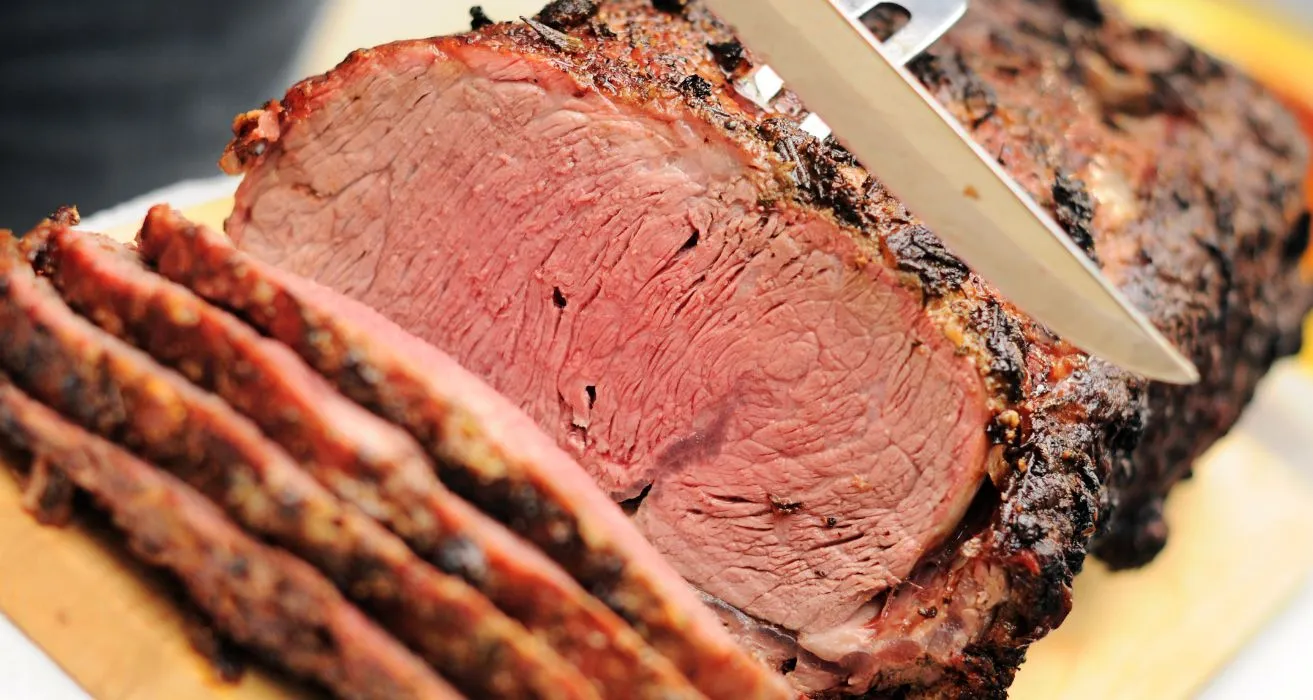In the culinary world, the quest for that perfect main course often leads us to the king of beef cuts: the prime rib. Known for its juicy, tender, and flavor-packed experience, prime rib stands as a testament to the art of cooking. But, what truly elevates this dish from good to unforgettable is the seasoning. Yes, the magic lies in those carefully chosen herbs and spices that form a crust, locking in flavors and making each bite a culinary delight. In this comprehensive guide, we’re diving deep into the world of prime rib seasoning. From selecting the right ingredients to the nuances of preparation, we’re covering it all. So, tighten your apron, and let’s embark on this flavorful journey together.
Ah, the aroma of prime rib roasting in the oven – is there anything quite like it? It’s not just the meat itself that tickles the taste buds but the seasoning that really brings the dish to life. Let’s unravel the secrets of prime rib seasoning, shall we?
What Makes Prime Rib Seasoning Special?
Seasoning a prime rib is not just about making it tasty. It’s about creating a symphony of flavors that enhance the meat’s natural richness. The right blend of seasoning can transform a simple cut of beef into a masterpiece that’s both elegant and bursting with flavor. Each spice plays a role, whether it’s adding a hint of warmth, a touch of sweetness, or a bit of zest.
The Importance of Prime Rib in Culinary Traditions
In many cultures, prime rib is more than just a meal; it’s a celebration. This majestic cut of beef, often reserved for special occasions, symbolizes abundance, luxury, and the joy of sharing a hearty, delicious meal with loved ones. Seasoning the prime rib is a craft, a tradition passed down through generations, each adding their own twist to the tale.
By understanding the art of prime rib seasoning, you’re not just preparing a dish; you’re continuing a legacy. It’s a culinary adventure that promises not just a feast for the stomach but also a journey for the senses. So, let’s dive deeper into the world of spices and herbs, unlocking the secrets to the perfect prime rib seasoning.
Essential Ingredients for Prime Rib Seasoning
The foundation of any good seasoning starts with understanding the components that bring out the best in your prime rib. Here’s a breakdown of the must-have ingredients and why they’re crucial for that perfect seasoning blend.
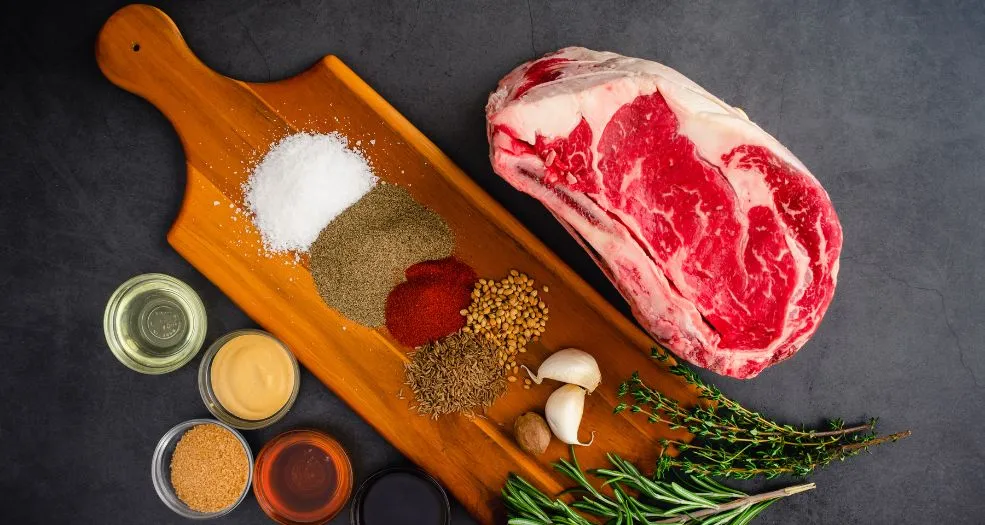
Salt: The Foundation of Flavor
Salt is more than just a seasoning; it’s the essence of flavor enhancement. It works by drawing out moisture and concentrating the beef’s natural flavors, creating a juicier, more savory prime rib. For a balanced seasoning, kosher salt is your best bet due to its coarse texture and ability to distribute evenly.
Black Pepper and Garlic Powder: A Classic Combo
These two spices form the backbone of most meat seasonings, and for good reason. Black pepper adds a warm, earthy kick, which complements the rich beefiness of prime rib. Garlic powder, on the other hand, introduces a subtle sweetness and depth, making the meat more aromatic and flavorful.
Adding Depth with Onion Powder and Paprika
Onion powder offers a sweet and savory note that pairs wonderfully with the robustness of beef. Paprika, whether smoked or sweet, lends a gentle heat and a hint of color, enhancing the visual appeal of your prime rib. Together, they layer additional complexity into the seasoning.
The Role of Herbs and Spices in Seasoning
Herbs such as rosemary, thyme, and oregano bring a fresh, aromatic quality to the mix. They introduce earthy, floral notes that brighten the seasoning and give it a distinctive character. Don’t shy away from experimenting with these to find your perfect herb combination.
Optional Ingredients for Customization
For those looking to tailor their prime rib seasoning, consider incorporating dried mustard for a tangy kick, brown sugar for a hint of sweetness, or even a pinch of cayenne for some heat. These optional ingredients allow you to customize the seasoning to your palate, making your prime rib uniquely yours.
Creating the perfect prime rib seasoning blend is an art form, a delicate balance of flavors that enhance without overpowering. As we venture further into the nuances of preparation and application, remember that the best seasoning is the one tailored to your taste. Whether you’re a seasoned chef or a culinary novice, mastering the art of prime rib seasoning is a journey worth taking. Stay tuned as we continue to explore the techniques that will ensure your prime rib is nothing short of spectacular.
Preparing Your Prime Rib
Before those spices even come close to your meat, there’s a bit of prep work involved. It’s these preliminary steps that set the stage for a prime rib roast that’s truly memorable.
Selecting the Right Cut
The journey to a perfect prime rib starts at the butcher’s counter. Opt for a cut with a good amount of marbling; those fat veins are where a lot of the flavors come from. A well-marbled prime rib promises juiciness and taste that leaner cuts simply can’t match. For an added layer of flavor and protection during roasting, choose a rib with the bone in. Not only does it look impressive, but the bones also act as a natural roasting rack and contribute to the meat’s overall succulence.
Pre-seasoning Preparation Steps
First things first, let’s talk about getting your prime rib ready for that seasoning. Begin by patting the meat dry with paper towels. Moisture on the surface can prevent the spices from adhering properly, so you’ll want to start with as dry a surface as possible.
Next up, if your butcher hasn’t already done so, consider trimming any excess fat from the top layer. A little fat is good for flavor, but too much can prevent the seasoning from reaching the meat underneath. Aim for a fat cap about ¼ inch thick for the best results.
Now, for a secret weapon – scoring. Gently score the fat cap in a criss-cross pattern. This not only helps the fat render more evenly but also creates tiny pockets for the seasoning to nestle into, ensuring every bite is as flavorful as the last.
Finally, let your prime rib sit at room temperature for at least an hour before seasoning. This step is crucial for even cooking. A cold center can lead to uneven roasting, with the outer layers overcooking while the inside remains underdone. Room temperature meat cooks more uniformly, giving you better control over the finished doneness.
With your prime rib properly prepped and primed for seasoning, you’re one step closer to achieving that show-stopping roast. Stay tuned as we dive into the art of seasoning application, where the spices you’ve meticulously chosen begin their magic, transforming your prime rib into a masterpiece of flavors.
Application Techniques for Seasoning
Seasoning your prime rib isn’t just about what you put on it, but how you apply those flavors. Here, we’ll explore the best techniques to ensure your prime rib is as delicious as it is impressive.
Dry Rubs vs. Marinades: What’s Best for Prime Rib?
While marinades have their place in the culinary world, for prime rib, a dry rub is king. Dry rubs cling to the meat, creating a crust that seals in juices and intensifies flavors during roasting. Marinades, on the other hand, can dilute the robust beefiness of prime rib. Stick with a dry rub to highlight the natural flavors of the meat.
Step-by-Step Guide to Seasoning Your Prime Rib
- Mix Your Seasoning: In a bowl, combine your kosher salt, coarse ground black pepper, garlic powder, onion powder, paprika, and your choice of herbs. If you’re feeling adventurous, throw in a pinch of dried mustard or cayenne for an extra kick.
- Apply the Rub: Start by drizzling a little olive oil over your prime rib—just enough to moisten the surface. Then, generously apply your seasoning mix, massaging it into every nook and cranny. Don’t forget the ends and the bone side; every inch should be covered.
- Let It Rest: Once seasoned, let your prime rib sit at room temperature for another 30 minutes. This allows the spices to meld with the meat, deepening the flavors before it hits the oven.
- Roast to Perfection: Preheat your oven and prepare for roasting. Remember, the goal is a crusty exterior with a juicy, tender interior. A good rule of thumb is about 15 minutes per pound for medium-rare, but always use a meat thermometer to ensure perfection.
By now, your prime rib is seasoned and ready for the oven. The anticipation builds as you imagine the final product: a crusty, flavorful exterior giving way to tender, juicy beef that’s bursting with flavor. Up next, we’ll delve into cooking tips and techniques that will ensure your prime rib is nothing short of spectacular. Stay tuned as we continue this flavorful journey.
Famous Prime Rib Recipes
Adding a savory twist to our prime rib journey, let’s delve into some famous prime rib recipes that spotlight our seasoned star. Each recipe brings its unique flair to the table, promising a delectable feast that’s bound to impress.
1. Classic Herb-Crusted Prime Rib
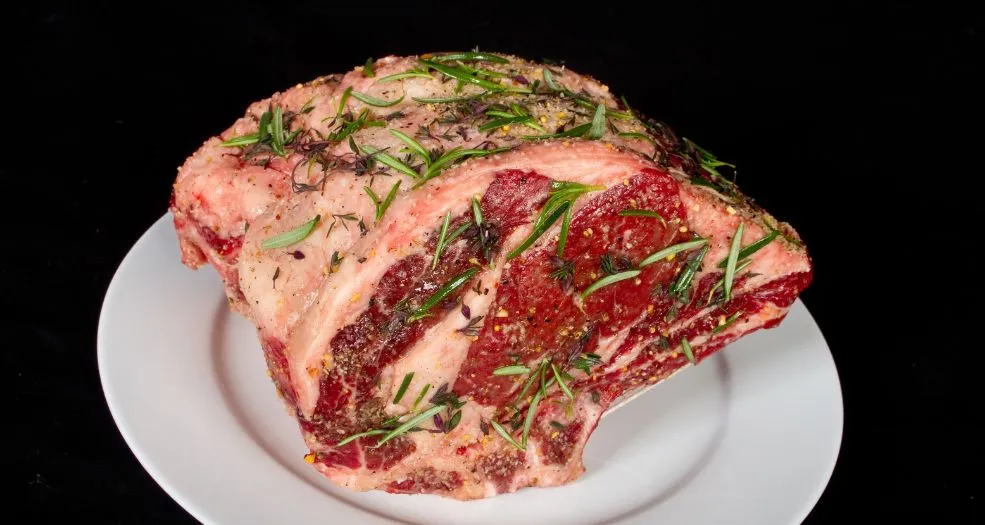
Ingredients:
- 1 (5-pound) prime rib roast
- 2 tablespoons kosher salt
- 1 tablespoon coarse ground black pepper
- 4 cloves garlic, minced
- 2 tablespoons fresh rosemary, chopped
- 2 tablespoons fresh thyme, chopped
- 1/4 cup olive oil
Directions:
- Prep the Prime Rib: The day before cooking, combine salt, pepper, garlic, rosemary, thyme, and olive oil to form a paste. Rub this mixture all over the prime rib, cover, and refrigerate overnight.
- Let It Rest: Remove the prime rib from the refrigerator 2 hours before cooking to bring it to room temperature.
- Cook: Preheat the oven to 450°F. Roast the prime rib for 20 minutes, then reduce the oven temperature to 325°F. Continue roasting until it reaches your desired doneness (about 15 minutes per pound for medium-rare).
- Rest & Serve: Let the prime rib rest for at least 20 minutes before slicing and serving.
2. Garlic Butter Prime Rib
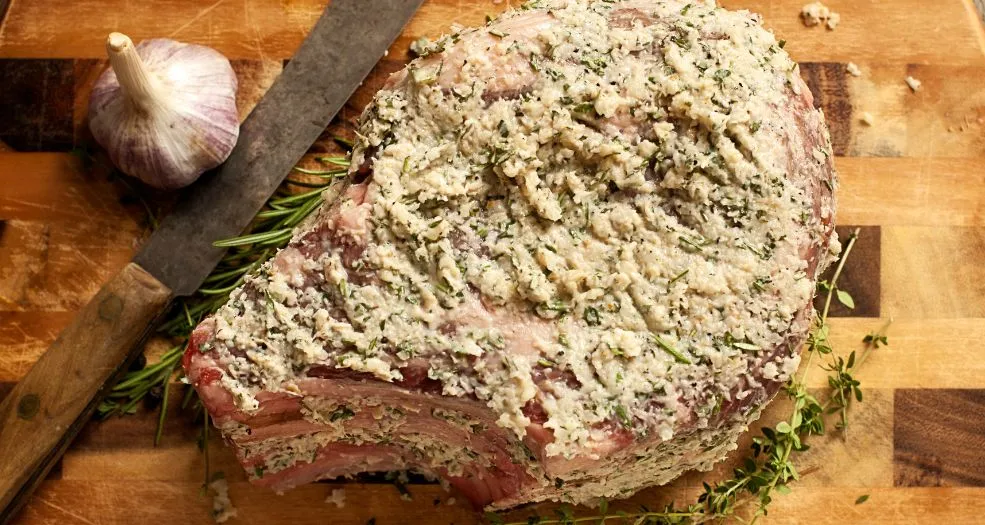
Ingredients:
- 1 (6-pound) prime rib roast
- 1 tablespoon sea salt
- 2 teaspoons black pepper
- 1/2 cup unsalted butter, softened
- 5 cloves garlic, minced
- 1 teaspoon dried thyme
- 1 teaspoon dried rosemary
Directions:
- Season: Mix salt, pepper, butter, garlic, thyme, and rosemary. Apply this garlic butter generously over the prime rib.
- Chill: Let the seasoned prime rib chill in the fridge for at least 4 hours, or overnight for better flavor infusion.
- Roast: Preheat your oven to 450°F. Start roasting at high heat for 20 minutes, then lower the heat to 350°F and continue until it’s cooked to your liking.
- Rest & Enjoy: Allow the meat to rest for 20-30 minutes before cutting into it. This ensures every slice is perfectly juicy.
3. Smoked and Spiced Prime Rib
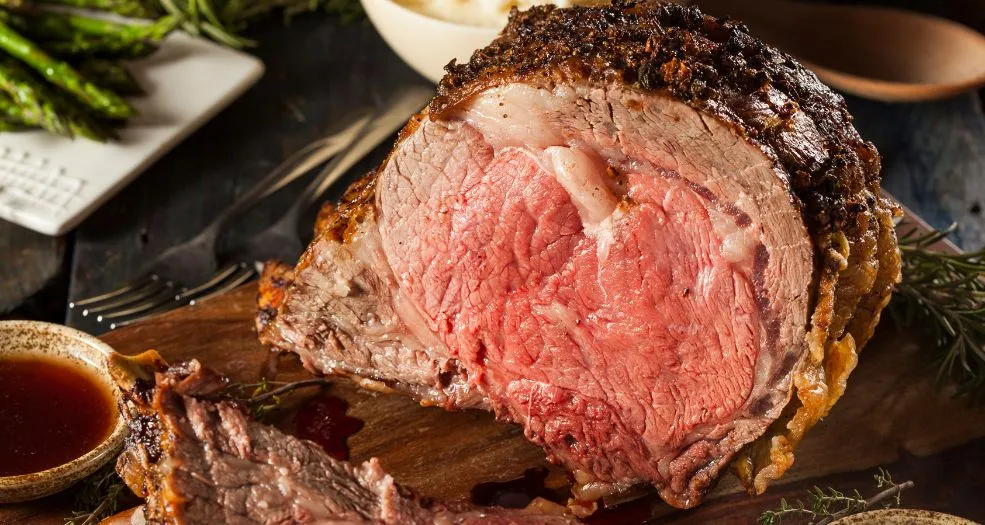
Ingredients:
- 1 (7-pound) prime rib roast
- 2 tablespoons coarse salt
- 1 tablespoon cracked black pepper
- 2 tablespoons paprika
- 1 tablespoon onion powder
- 1 tablespoon garlic powder
- 1 teaspoon cayenne pepper (optional for heat)
- Wood chips (for smoking)
Directions:
- Combine Spices: Mix together salt, pepper, paprika, onion powder, garlic powder, and cayenne pepper.
- Rub: Coat the prime rib evenly with the spice mix. Let it sit overnight in the refrigerator.
- Smoke: Preheat your smoker to 225°F. Place the prime rib in the smoker, using your choice of wood chips to infuse flavor.
- Cook Slowly: Smoke the prime rib for about 3 to 4 hours, or until it reaches an internal temperature of 130°F for medium-rare.
- Rest & Slice: Let the prime rib rest for 20 minutes before slicing. Serve with your favorite sides for a memorable meal.
These recipes showcase the versatility and depth of flavor that prime rib can offer. Whether you’re in the mood for something classic, craving the richness of garlic butter, or eager to explore the smoky depths of a spiced rub, there’s a prime rib recipe here for every palate. Enjoy the process and the feast that follows!
Cooking Tips and Techniques
The method you choose to cook your prime rib can make all the difference in achieving that perfect balance of crusty exterior and tender, juicy interior. Let’s walk through the essentials to ensure your prime rib roast is the star of the show.
Roasting: The Preferred Method for Prime Rib
Roasting is the time-honored technique for prime rib, allowing the meat to cook evenly while developing a rich, flavorful crust. Here’s how to roast your prime rib to perfection:
- Preheat Your Oven: Start by preheating your oven to a high temperature (around 450°F) to create a nice sear on the outside of the meat, locking in those juicy flavors.
- Start with a Sear: Place your seasoned prime rib in the preheated oven for about 20 minutes, then reduce the temperature to around 325°F. This initial high heat will help develop a flavorful crust.
- Low and Slow: After searing, cooking the meat at a lower temperature allows it to roast slowly, ensuring the inside is cooked to your liking without overcooking the outside. Use a meat thermometer to monitor the internal temperature. For medium-rare, aim for an internal temperature of 130°F before resting.
- Rest Before Carving: Perhaps the most crucial step, resting allows the juices to redistribute throughout the meat, ensuring every slice is as juicy and flavorful as possible. Let your prime rib rest for at least 20 minutes before carving.
Tips for Ensuring a Juicy, Flavorful Roast
- Don’t Skip the Rest: Allowing your prime rib to rest after roasting and before carving is non-negotiable. This step is key to a juicy, flavorful roast.
- Monitor Temperature Closely: Investing in a good meat thermometer can make the difference between an okay roast and a spectacular one. Remember, the meat will continue to cook slightly as it rests, so pull it out a few degrees before your target doneness.
- Carve Against the Grain: When it’s time to serve, carve your prime rib against the grain for the tenderest slices.
By following these guidelines, you’re well on your way to presenting a prime rib that’s not just a meal but an experience. A symphony of flavors, a testament to the care and creativity you’ve poured into every step. And as we wrap up this journey, remember, the joy of cooking comes not just from the delicious end product but from the process itself. Stay tuned for our conclusion, where we’ll tie all these threads together into a final feast for the senses.
FAQs:
Even with all the information in hand, questions often arise, especially when tackling a dish as grand as a prime rib. Here, we’ll address some frequently asked questions to demystify the process further.
Do you season prime rib before cooking?
Yes, seasoning prime rib before cooking is crucial. It’s recommended to season it at least overnight, preferably even longer, up to 36+ hours. This approach helps to dry the surface of the meat, which is desirable for creating a flavorful crust.
What’s a good rub for a prime rib?
A good rub for prime rib includes a balance of kosher salt, coarse ground pepper, dried herbs (like oregano, basil, thyme, and rosemary), garlic powder, and onion powder. Smoked paprika can also add a rich savory flavor. These ingredients blend together to enhance the meat’s natural flavors.
How to add flavor to prime rib?
To add flavor to prime rib, liberal salting and refrigeration for several days before cooking are key. This method concentrates the meat’s flavors. High-quality, dry-aged prime rib, seasoned with salt and pepper and possibly marinated, yields the best results.
What is the secret to a good prime rib?
The secret to a good prime rib lies in quality, preparation, cooking technique, and rest time. Opt for high-quality, well-marbled, and if possible, dry-aged prime rib. Season it well in advance, start cooking with high heat to develop a crust, and then lower the temperature to cook slowly. Always let it rest before serving to ensure juiciness.
Can I season my prime rib in advance?
Absolutely! In fact, seasoning your prime rib a day in advance can enhance the flavors even more. The salt and spices have more time to penetrate the meat, resulting in a deeper, more robust taste.
How much seasoning should I use for my prime rib?
A good rule of thumb is about ¾ to 1 teaspoon of salt per pound of meat. For the rest of your spices, it’s about balance. You want a nice crust of seasoning, but not so much that it overwhelms the natural flavors of the prime rib. Aim for a light, even coating.
Can I reuse prime rib seasoning?
If you’ve made a custom blend and have leftovers, you can definitely save it for next time. However, if any of the seasoning has come into contact with raw meat, it’s best to discard it to avoid cross-contamination.
Conclusion and Final Thoughts
Navigating the world of prime rib seasoning and preparation might seem like a daunting task, but remember, at the heart of it all is the simple act of cooking—a gesture of love, creativity, and sharing. The key takeaways from our journey? Patience, care, and a bit of boldness in experimentation. Whether you’re a seasoned chef or a home cook, the most important ingredient you can bring to your kitchen is a willingness to learn and explore.
As we conclude this guide, remember that cooking is as much about the mistakes as it is about the triumphs. Each attempt brings you one step closer to mastering the art of the perfect prime rib. So, embrace the process, enjoy the flavors, and most importantly, share the feast with those you love.
Thank you for joining me on this flavorful adventure. May your kitchen always be filled with warmth, laughter, and delicious aromas. Happy cooking.
